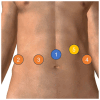Robot‑assisted laparoscopic partial cystectomy for urachal carcinoma: A case report
- PMID: 40213090
- PMCID: PMC11983371
- DOI: 10.3892/ol.2025.15003
Robot‑assisted laparoscopic partial cystectomy for urachal carcinoma: A case report
Abstract
Urachal carcinoma is a rare and aggressive malignancy with an unknown aetiology and poor prognosis. The present case report described a 31-year-old male patient who initially presented with a 5-day history of haematuria. FDG-PET/CT demonstrated nodules in the anterior wall of the bladder with increased glucose metabolism, which were suggestive of malignancy. A cystoscopic biopsy confirmed the diagnosis of urachal carcinoma. The patient underwent en bloc robot-assisted laparoscopic modified partial cystectomy, along the umbilicus and urachus resection, and pelvic lymph node dissection. The patient recovered within 2 weeks postoperatively, with complete tumour resection confirmed by pathological analysis, which showed negative margins and no recurrence was detected during a 5-month follow-up. The current case highlighted the potential of robot-assisted laparoscopic surgery as an effective treatment option for urachal carcinoma, offering insights for further optimization and broader clinical application, and reviewed the currently available literature.
Keywords: cystectomy; robot-assisted laparoscopic; urachal carcinoma.
Copyright: © 2025 Ye et al.
Conflict of interest statement
The authors declare that they have no competing interests.
Figures




Similar articles
-
Robotic assisted laparoscopic partial cystectomy and urachal resection for urachal adenocarcinoma.Int Braz J Urol. 2009 Sep-Oct;35(5):609. doi: 10.1590/s1677-55382009000500014. Int Braz J Urol. 2009. PMID: 19860941
-
En Bloc Robot-assisted Laparoscopic Partial Cystectomy, Urachal Resection, and Pelvic Lymphadenectomy for Urachal Adenocarcinoma.Rev Urol. 2015;17(1):46-9. Rev Urol. 2015. PMID: 26029004 Free PMC article. Review.
-
Primary urachal adenocarcinoma treated with partial cystectomy - Case report.Int J Surg Case Rep. 2025 Jun;131:111449. doi: 10.1016/j.ijscr.2025.111449. Epub 2025 May 16. Int J Surg Case Rep. 2025. PMID: 40381334 Free PMC article.
-
Single-Port Robot assisted partial cystectomy for urachal adenocarcinoma.Int Braz J Urol. 2024 Sep-Oct;50(5):659-660. doi: 10.1590/S1677-5538.IBJU.2024.0379. Int Braz J Urol. 2024. PMID: 39106120 Free PMC article.
-
[Carcinoma of urachus: report of 15 cases and review of literature--is total cystectomy the treatment of choice for urachal carcinoma?].Nihon Hinyokika Gakkai Zasshi. 2003 May;94(4):487-94. doi: 10.5980/jpnjurol1989.94.487. Nihon Hinyokika Gakkai Zasshi. 2003. PMID: 12795163 Review. Japanese.
References
Publication types
LinkOut - more resources
Full Text Sources
Research Materials
